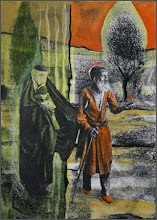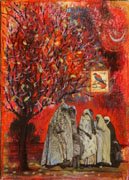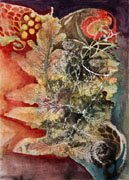
Two years of exploration have culminated in a body of work being currently shown at Augusta Savage Gallery, University of Massachusetts, Amherst.
This is the introduction to my process given at the opening May2,2011
at the request of viewers.
The work can be seen in a slide show at http://www.artistsofleyden.org
“Energetic Revelations” refers to the spontaneous and intuitive approach that was taken in creating this body of work. It was my goal to disassociate from the end result, to forgo conscious intellectual judgment during the process and keep my artistic ego in the background as much as it is humanly possible. I wanted as direct a means of expression as I could put on paper and later on canvas.
This journey began two years ago when I had the good fortune to collaborate on an interactive art work that was presented at the Zendai Museum of Contemporary Art in Shanghai. After visiting the Shanghai Museum and deepening my appreciation of Chinese ink paintings, I purchased some horse hair calligraphy brushes and determined to explore traditional Chinese painting on my own.
The results were humbling and discouraging. The dynamic characters I tried to copy were clumsy and wooden from my untrained hand, but the brushes were divine. I loved their flexibility and responsiveness to the tiniest movement. It was like holding the reins on a thoroughbred racehorse. I could feel the potential of these instruments. To my delight, I found that if I held the brush at the handle’s end and let it respond to the most subtle gesture, a wonderfully graceful and expressive line was created. I had to disconnect from trying to control the results and let the ink loaded brush lead the way.
It became a visual dance as I tenuously released fear and gave myself over to the process. I blurred my vision by squinting so I couldn’t judge what was being put down and soon marvelous forms were revealed. It was instantaneous and required me to literally “go with the flow”.
The speed was exhilarating and the slightest hesitancy immediately created a train wreck…
I began to trust the process and work larger, eventually using a dowel with my brush taped on the end to get more physical distance and worked with the paper on the floor, as I stood over it.
I had feelings of lyrical verse flowing from the brush in the smaller works and the early large ones. I felt they were melodious, whispered poetic phrases. But soon I felt I was taking urgent dictation from a different “voice”.
Later I noticed that these strong expressions seemed to coincide with natural disasters and dramatic weather events…it was like Earth herself was urging me to pay attention to what is going on. Heat waves, volcanoes, hurricanes, microbursts, the Gulf oil disaster all were recorded here. As an interesting aside, I do not have television reception in the wooded hills where I live. I had limited exposure to visuals online prior to and during this work. This added to the sense of surprise when obvious correlations were discovered.
As a dealer in the traditional arts of tribal peoples for the past 30 years, I have a background in cultural anthropology. The mark making that became primitive alphabets and sacred calligraphy were ultimately symbols of power, the word made visible.They were transmitted to shaman/priests from the world of spirit or Divine realm in ritualized settings.
All cultures have examples of this. The earliest Chinese characters were etched onto oracle bones in 2,000 BC/CE. Other examples include Nordic runes, Haitian ve-ve, and Arabic calligraphy. In South East Asia it is still practiced today by animist -Buddhist monks of great power.
In 19th C. psychiatry this method of intuitive discourse was termed “automatic writing”. The Surrealists felt that automatism was a higher form of behavior than the constrictive reflexive one that psychiatrists deemed it to be. They believed that automatism directly expressed the creative force of the unconscious in art. It became part of their Manifesto and the cornerstone of Surrealism.
Andre Masson led the charge in the Surrealist circle with automatic drawing and poetry writing. Later the leading lights of the Abstract Expressionists: Pollack, Krasner, de Kooning, Motherwell and Kline all met regularly to experiment with spontaneous drawing, poetry and introduced various glyphs and calligraphic elements into their paintings. Other New York artists of the 1940-50s, Pousette-Dart, Twarkov , Tomlin and Gottlieb developed work around these themes as well. Interestingly, many of these artists were aware of and interested in ethnographic art termed “Primitive Art” at the time and read books on anthropology and Jungian psychology. I have enjoyed discovering affinities with these action/gesture painters.
Many artists outside of these circles created a similar visual language at a slower
Speed, most notably Miro, Klee, Mark Tobey, especially his White Writing series, Brice Marden and Cy Twombly.
There are so many I have yet to discover that found themselves on this path during their experimentation. I love the synchronicity of discovering other kindred spirit painters at just the right moment.
In my personal approach to direct painting in oil, I found the gestural flow translated differently in the viscous nature of the paint. Spontaneity was curtailed by the drying time between layers. What resulted was more of a short hand dictation in some cases and calligraphic arabesques in others. As in the works on paper, intellectual premeditation was avoided and the finished works were still “revelations” to me…
My art making has in turn been visionary and symbolist for the past decade.
This foray into abstraction has opened me to infinite possibilities of expression and I can tell that it has only just begun.




















